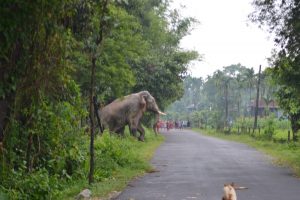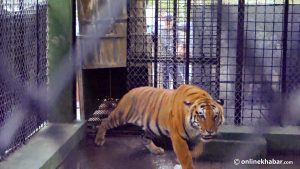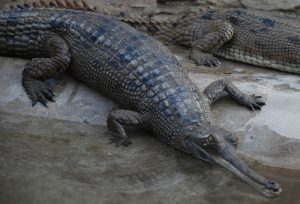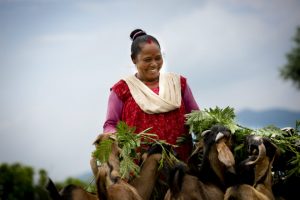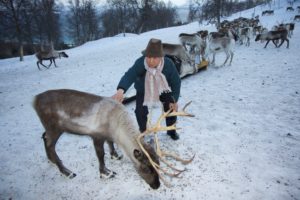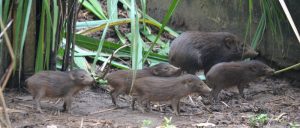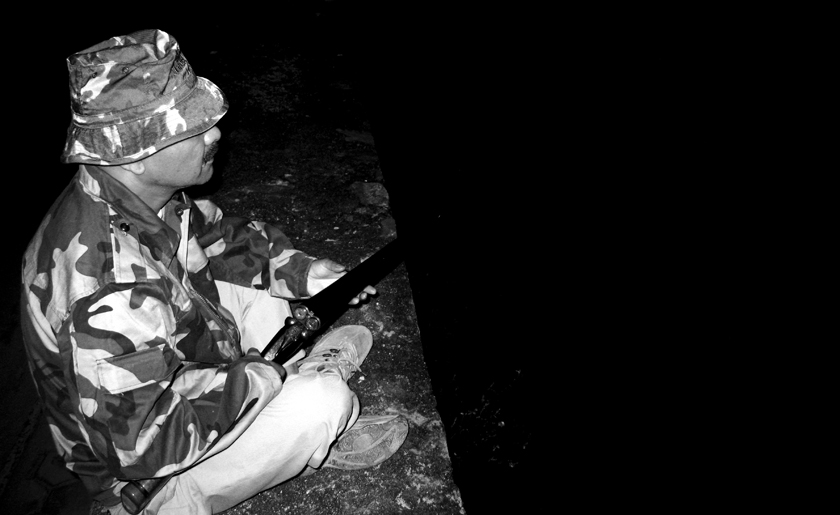
For close to four hours I had crouched on the machan with a shotgun on my lap and a flashlight in my hand, keeping the night vigil for my quarry–the wild boar.
I got more and more uncomfortable with each passing minute. The late July night after the rains was relatively cool; but, to my great misery, the mosquitoes were out in force and my skin crawled at the thought of the leeches around my ankles, gorging themselves on my blood.
“Ho ho, ha, ha,” the ear-piercing hoarse cry suddenly ripped the stillness of the night, followed by a loud beating of tin cans–the sound bouncing off the hillside.
The noise jerked me wide awake. Instinctively I grabbed for the gun, my heart in my mouth. In the frantic lunge, the flashlight slipped and I swore under my breath.
Groping in the darkness, I found it lying on the floor of the machan, my lookout post several feet up from the ground. I waited with bated breath for something to happen but soon a deathly hush descended over the night.
The silence was then broken as a barn owl hooted nearby, the screeching sound lending more eeriness to the dark night. I learned in the morning that the nighttime racket made by the villagers was intended to drive away the wild boar from the corn fields.
The wild boar hunt for me and my two partners was more of a mission than an outing. The location was Bhirkot, a small village just 12 kilometres from the heart of Kathmandu. The year was 1990.
We were supposed to shoot the wild boars that were destroying the villagers’ crops.
I had never heard of Bhirkot until one day Ramesh, my shooting companion and a doctor, told me about it. He had a patient from Bhirkot who bemoaned the havoc wreaked by wild boar in his village.
That was all the enticement we needed. Hunting fanatics that we were, we set off for Bhirkot the following weekend, intent on remedying the issue. Nirmal, our third companion joined us at the last moment.
Barely a half-hour ride on our motorbikes west of Sitapaila to Ramkot, then a 45 minute hike uphill to the north, Bhirkot was a cluster of 30 to 40 houses scattered amidst terraced fields on a hillside.
A stunning view of the Kathmandu Valley dominated the southeast and the towering ridge of the Nagarjun Forest Reserve, a haven for wild boar, flanked the north. The landscape west of the village stretched into the forested hills of Bhimdhunga.
Once at the village, Govinda, our host and Ramesh’s patient, over a cup of tea, assured us that it was okay to shoot the boar as they were declared pests and their village committee had acquired special permission from the government.
Our arsenal for the hunt included an odd assortment of 12-gauge shotguns. Ramesh carried a Russian-made Baikal single-barrel that, when fired repeatedly, became really hot. Nirmal sported an antique British gun, a 34-inch Greener inherited from his father, which often jammed at the wrong moment.
I was fortunate to have a double-barreled Webley & Scott, also British, which gave me an edge over my mates, as I could go for a quick second shot if need be.
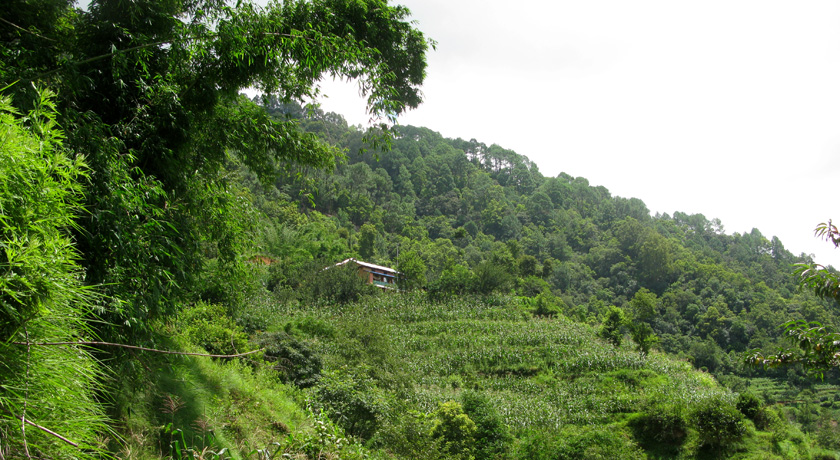
Our visit to Bhirkot confirmed that the plight of the villagers was for real. At several locations, the maize crop – or what remained of it – lay trampled and chewed every which way we looked, as if the entire field had suffered a massive typhoon overnight.
We wondered how the boar managed to get into the fields, confined as they were to the forest by a sturdy-looking boundary wall. We made a tour of the fields and found that the wall was not high enough some places to frustrate the sinewy legs of the wild pigs and, worse still, it had caved in at several locations.
The wild hogs apparently stormed the crops in pairs or groups, covering as many as eight to ten different spots in a single visit. Not in daylight, though. Smart and wary, they bid their time until dark.
If the damage caused by the boar’s night sorties continued unchecked, I could well imagine what would remain of the crops by the harvesting time.
At night, villagers took turns to keep guard. To ward off the boar, empty tin cans were beaten and, the villagers resorted to yelling and shouting. Every year, with the help of government shikaris, or hunters, a few of the animals were even shot.

“The boars have grown in numbers so rapidly each year that both the Nagarjun and Shivapuri forests fail to provide for them,” Govinda, our host, told us.
The main reason for such rapid growth in the number of wild boar was not difficult to understand, as Govinda explained.
“A prolific breeder, a sow bears five or six piglets up to twice a year and the gestation period is just four months. The government does not allow hunting and, although the forest does have some leopards that can cull, they have not been very effective in reducing the numbers.
“Given the population boom and their notorious gluttony,” continued Govinda, “the forest of Nagarjun and Shivapuri fail to offer enough food for these wild critters. Consequently, the boars move out beyond the forest walls to the neighboring fields.”
My night vigil on the machan ended with the first streaks of dawn, with no sight or sound of a wild boar. I clambered down and called out to the old man sleeping in the nearby cowshed.
As I bid him goodbye on my way back to the village, he mumbled some words of thanks for having kept the night watch for him. The poor fellow must have slept well after a long time, since I had relieved him for the night.
“Hajoor, each night my son Maila and I take turns to shoo the pigs away,” was his parting lament.
I knew that neither of my companions lying in wait 200 yards apart had had any better luck, as no tell-tale gunshot was heard during the night. Ramesh, however, had a hair-raising account.
Around midnight, he heard a boar barely 20 paces from where he was crouched amidst the corn stalks. He stalked it in darkness, virtually crawling on all fours, until he thought he could all but reach out and literally touch the animal with his bare hands.
Unaware of the danger from Ramesh, the boar kept chomping at the cobs, the sound like small crackers going off in the calm of the night.
Shaking with nervous excitement, Ramesh squinted into the dim moonlight trying hard to locate the source of the noise. He knew that to venture further would put him in danger, for wild boars are said to be treacherously aggressive. And he could no way shoot at the sound alone.
Ramesh made a frantic gesture to his village mate, who was bringing up the rear, to switch on the flashlight but, before the jumpy chap could train the light on the quarry, the boar spooked. The startled animal made an explosive dash, brushing past Ramesh and was gone in a dim blur in the moonlight.
“I almost suffered a cardiac arrest,” Ramesh finished in mock fear with a melodramatic gesture.
Last to appear that morning was a weary Nirmal, with bloodshot eyes, droopy shoulders and disappointment written all over his face. He, too, had a bizarre encounter.
“I saw not one but two of them,” he told us. We were all eyes and ears to hear his story.
After an uneventful, all-night vigil on a tree, Nirmal climbed down the tree with his village companion and headed for the village. As they trudged down a slope, he heard people talking in the distance.
It never occurred to Nirmal that a wild boar might cross their path, highly unlikely as it was for the animal to hang around after daylight and in the proximity of humans. But one did. Caught unawares, the two men froze in their tracks as their eyes locked on a big boar hardly ten feet away.
“Time stopped,” Nirmal said, “My heart kicked furiously at the sight of the hefty black boar staring back at me. Then, in a flash, the beast dashed for cover before I could even flex a muscle.”
He seemed breathless as he spoke. That was not all. Within seconds, yet another boar whizzed past and all he could do was watch helplessly.
So much for our wild boar hunt!
Back at the village, as we sipped tea at Govinda’s house; he graciously soothed our sapped spirits by assuring us of good luck the next time. We thanked him and the many villagers who had thronged to bid us goodbye and set off down the slope.
As I lay in the comfort of my bed that night, musing over the sequence of events at Bhirkot, the face of the old man kept flashing in my mind. He was at that very moment probably sitting it out on the machan, fighting a wretched battle against the nocturnal marauders of Bhirkot.
“Maybe we ought to make one of those hunting trips to Bhirkot again, if only for the old man’s sake,” I said to myself.
Singh is a 65-year-old outdoors man, lost in his own little adventures. Interests? It used to be hunting; it stopped during the Maoist insurgency. Then came fishing followed by mountain biking. So, his passions are writing, mountain biking and fishing. Ambition? Ride his mountain bike from Beni, Baglung, to Lo Manthang and Upper Mustang.




